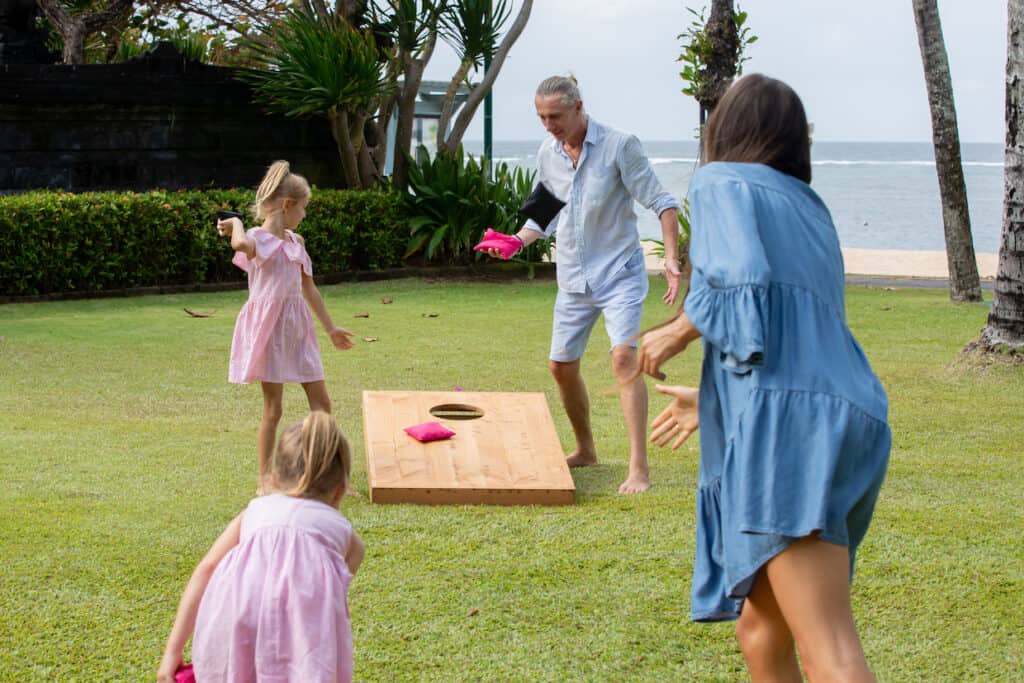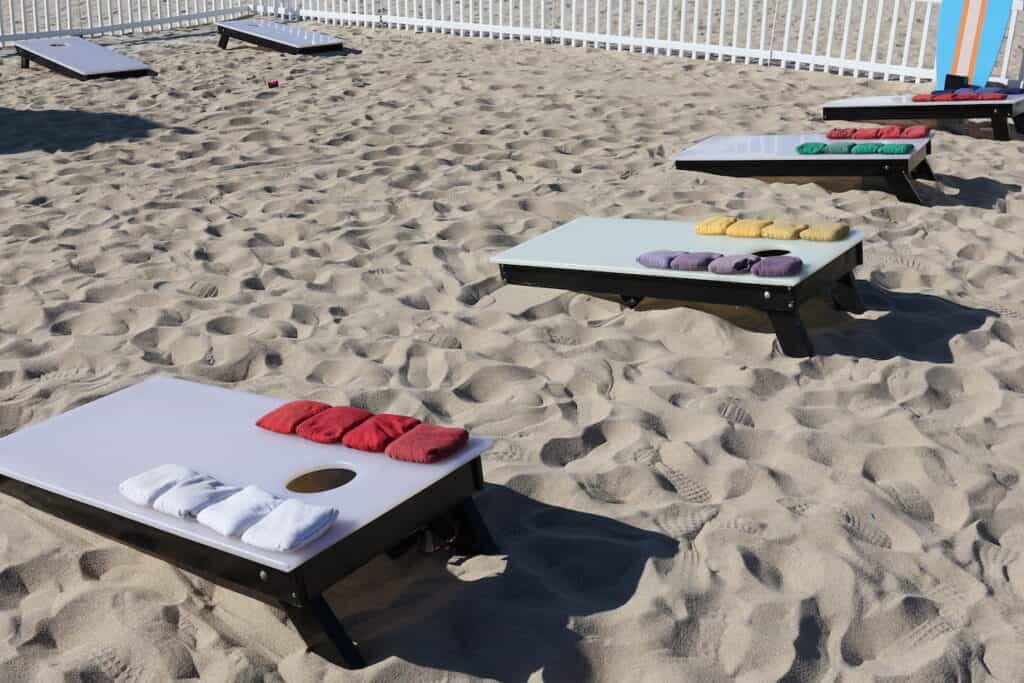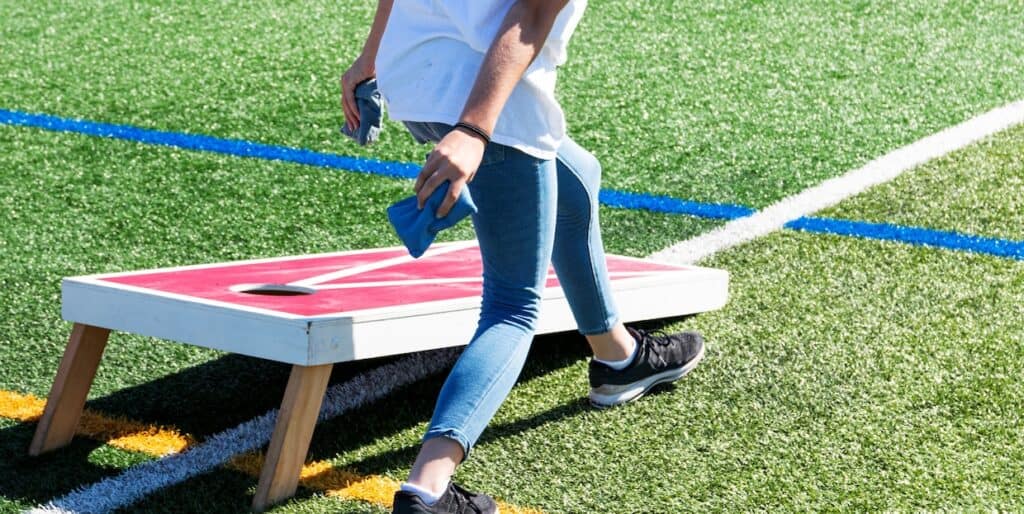If you loved playing bean bag toss as a child, then you’re going to love setting up cornhole boards and trying your hand at this friendly sport. It’s fun and something people of all ages can play. Read on to learn the sport’s rules and why it’s become so popular in the United States.

What is cornhole, and why does it have boards?
The game cornhole involves tossing a beanbag into a hole on a slanted board from a specific distance away. For a simple game, it is highly popular.
Just like pickleball, cornhole is a fast growing sport. According to an IPSOS sports poll, cornhole and bowling were the sports most Americans played last year.
Most cornhole players are men between the ages of 21 and 45, Sports Destination Management reported. So if you’re stumped for an anniversary gift for him, cornhole boards just might be the answer.
Rules of cornhole
One such rule, according to the American Cornhole League — and yes, there is a professional organization for players — is the size of the cornhole boards. They are typically 4 feet by 2 feet, with one pair of legs towards the back of the board where the hole is. That’s the headboard. Ideally, it should stand 12 inches tall.
Then, the rest of the board slopes down toward the ground. The part closest to the ground is called the footboard.
There’s a second professional organization for this sport called the American Cornhole Association. According to their regulations, the hole on the cornhole board should be 9 inches from the headboard and 12 inches from each side. The hole itself should have a 6-inch diameter.

Why is it called cornhole? Because the beanbags you use are filled with dried corn kernels. Other names for the game include bean bag toss and tailgate toss. On some college campuses, cornhole goes hand in hand with Jello shots for fun at a party.
Tailgating is where Sara Nelson of Real Balanced plays cornhole the most.
“We love to play cornhole, especially when tailgating at baseball or football games for our favorite Wisconsin-based teams,” she said. “It’s a relaxed game that allows us to talk and joke while playing but also includes some friendly competition.”
Why boards for playing cornhole? Who knows. The sport’s origins aren’t clear-cut. However, all cornhole boards are wooden.
Popularity of cornhole
According to ESPN, during the pandemic, televised cornhole tournaments took the place of other professional sports that had been canceled. Suddenly, this game was everywhere on TV.
Also, because you typically set up cornhole boards outside to play, it was something people could do together outdoors, despite lockdowns and social distancing. It offered a change from the same old family board game night.
In addition to those aforementioned tailgating parking lots, you’ll often find cornhole games set up at public parks, beaches, outdoor weddings or even restaurants and breweries.
“My parents own a small brewery in Northern California and purchased a cornhole set that people can play when they have live music,” said Gen La Rocca of Two Cloves Kitchen. “It’s such a simple game, but everyone seems to love the atmosphere it creates with some good beer, food and music.”
How to play cornhole

For the amateur player or backyard enthusiast, setting up a game of cornhole is fairly simple. You can play on sand, grass or pavement.
Of course, you need two cornhole boards and bean bags for tossing. You can buy a complete set of boards and bags for about $100 on Amazon.
Setting up and playing the game
As far as the spacing of the cornhole boards, use a measuring tape for setup.
Here are suggestions, courtesy of the American Cornhole League:
- Set up boards so that the holes on the boards are farthest away from one another. In other words, the footboards are facing each other.
- If all adults are playing, you’ll want the front of each cornhole board to be 27 feet apart.
- If kids are playing, you can move the boards closer so that they are only 12 feet apart.
You can play with one person against another or a team of two. Each team gets four bean bags to toss during their turn. So, on a team of two, each person would toss two bean bags each during a turn. Or, they could toss all four and then their partner would toss all four the next time.
You stand on either side of the cornhole board to take your turn, tossing your beanbag toward the other team’s cornhole board. The so-called pitcher’s box, where you toss, is in front of the headboard but behind the footboard.

Cornhole scoring
- Where the beanbags land on the cornhole board determines the scoring, and there are two ways to earn points.
- If a beanbag lands on top of your opponent’s board, you earn one point.
- If you throw a bag through the hole or you knock your teammate’s bag into the hole, you earn three points.
- Any beanbag that misses the board or hits it and then slides off doesn’t earn points.
- You play alternating turns until one team earns 21 points.
Final thoughts
If it’s been a long time since you invested in lawn games for a backyard barbecue, you won’t go wrong with buying cornhole boards and beanbags. You can get them from nearly every online retailer, from Amazon to Target.
“We love to play cornhole as a family. It gives us something to do when we’re grilling, gets the kids off their phones or electronic games and facilitates conversations between the four of us,” Paula Jones of Call Me PMc said. “It doesn’t require a lot of skill, and it’s a fun competition.”
Trust us, your guests and family will thank you for setting up a cornhole game at your next backyard gathering.
Leah Ingram is the author of 15 books, including “Suddenly Frugal: How to Live Happier and Healthier for Less” and “The Complete Guide to Paying for College.” She shares shopping advice for getting the most value for your time and money at Leah Ingram Real Sophisticated Consumer.